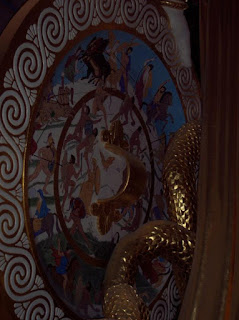In November, 2008, I took a short trip to
Nashville, Tennessee to spend the Thanksgiving holiday with my sister and brother-in-law. They surprised me with a tourist stop at the Nashville Parthenon, which
I didn't even know existed at the time! Here are some great pictures of the exterior taken by my brother-in-law during that trip, and a few interior photos taken by my father in 2010.
 |
| Casual football and soccer games outside the Parthenon |
As we drove up, I was amazed at how big the Parthenon was! It wasn't until I witnessed this scene that I believed my sister's explanation that the Nashville version really is a
built-to-scale replica of the original Parthenon in Greece.
Text taken from a plaque located outside the front entrance:
The world's only replica of the Parthenon, epitome of Greek culture, was the central building at Tennessee's Centennial Exposition, May 1 through October 31, 1897. The original temple, dedicated to Athena, Greek goddess of wisdom, occupied the most sacred area in ancient Greece, the crest of the Acropolis, a hill overlooking Athens.
"The reception of the Centennial--it was the first exposition in the nation to be both an artistic and financial success--and public response to the Parthenon indicated that, although it was made of temporary materials, it should be reconstructed on a permanent basis. Construction was started in 1921, the exterior completed in 1925, but due to the lack of funds, it was not until May 20, 1931, that the Parthenon as it stands today was opened to the public.
The type of facade sculpture work at the top of the temple's exterior is called a "frieze." The frieze work on the Parthenon tells the story of
Athena's glorious battle with Poseidon.
Above front entrance: Here, close-up, you can see
Athena on the left,
Poseidon on the right; spear against trident!
Above the back entrance of the temple, another frieze tells the end of the battle story.
Zeus supervises a victory ceremony from his throne, while
Poseidon cowers behind him. To his left are the seductive
Aphrodite, and low-throned
Hades. In the center,
Nike, the winged goddess of victory, bestows upon Athena the victor's crown of laurel leaves.
Below the frieze are a border of small facades, most displaying
Centaurs engaged in their usual drunken pleasures: nymph-wooing, or violence.
Athena is supported on the right by several gods. First helmet-wearing
Ares, god of war.
Artemis with her hunter's bow is trying to get a better look.
Hera sits comfortably, accompanied by her symbol, the peacock. Behind her are
Hermes (winged cap and sandals, caduceus in hand), and
Apollo, holding his lyre.
A smaller frieze, displayed in the temple's interior shows the same image.
The most impressive of all is the statue of Athena inside the temple.
|
 Athena holds the goddess of victory, Nike, in her right hand, a spear and shield to her left. Athena holds the goddess of victory, Nike, in her right hand, a spear and shield to her left.
Text taken from a plaque inside the temple:
In Greek mythology, Athena is the goddess of wisdom and useful arts, and the protector of cities. Her title, Athena Parthenos, refers to her status as a maiden goddess; the name for the Parthenon is derived from this epithet, and translates into English as "The House of the Maiden." Born from the head of Zeus, King of the gods, Athena inherited much of her father's power and wisdom. Athena's pre-eminent place in the myths depicted on the artwork adorning the Parthenon also reflects the pre-eminent position the city of Athens enjoyed in the mid-fifth century B.C.
1. The Serpent. Thought by some to represent Ericthonios, a legendary, deified kind of early Athens, the snake is thought to symbolize the people of Athens themselves, who, like this creturs of the earth rose "from the soil of Attica."
2. The Shield. Athena's shield protects the snake, indicating her role in defending the people of Athens from harm.
3. The Helmet. The three crests of Athena's helmet are supported by mythological creatures: on the left and right a pegasus, and in the center a sphynx (half woman, half lion)"
4. The Aegis. the armored breast plate Athena wears on her shoulders is said to have magic powers. Given to her by Zeus, the Aegis makes Athena impervious to her enemies' weapons. In the center of the breast plate is the Medusa's head, giver by Perseus in return for Athena's help in killing Medusa.
5. The Sandals. Athena's sandals are decorated with images depicting the slaying of Centaurs.
6. The Frieze. The golden frieze across the front of the marble base depicts the birth of Pandora, whose name means "all gifts." The figures in order from left to right are Helios, Hermes, Hera, Zeus, Nike, Dionysus, the three Horai, Pandora, Hephaistos, Athena, Poseidon, Artemis, Apollo, Ares, Demeter, Hestia, Eros, Aphrodite, and Selene."
Upon leaving the Parthenon, my sister and brother-in-law informed me that there was a very different park nearby filled with allusions to Greek mythology and other fairy tales. I never would have imagined this:
But there it was: in the center of the park, a huge cartoon covered leviathan! I thought for a moment that I was on an episode of Sesame Street.
The entire monster was covered with little mosaic tiles depicting crude, but charming versions of fabulous legendary characters from classic children's literature, popular movies, and old legends. Here are a couple of allusions to Greek Mythology:
|














No comments:
Post a Comment